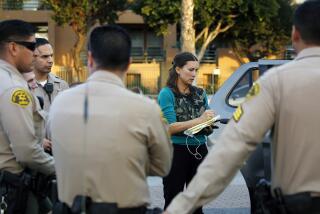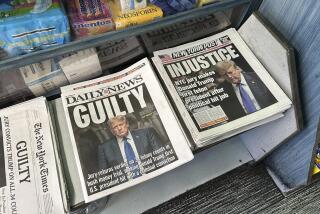Response to scandals validates credibility
- Share via
IT’S only a matter of time until the scandal involving New York Times reporter Jayson Blair, the appalling meltdown at the Salt Lake City Tribune and the Los Angeles Times’ recent dismissal of a photographer who filed an altered photo from Iraq are linked in a broad new indictment of the news media’s standards and credibility.
Distressing as they are, all three cases can just as easily -- and far more accurately -- be made to stand as a lesson in how the speed and implacability of the Fourth Estate’s self-correcting mechanisms are unmatched by any other institution in American life.
In part, that’s because the savage and ever-intensifying competition that pushes a handful of journalists into cutting ethical corners also forces their employers to deal decisively with them before their competitors do.
Nowadays, editors and news directors operate in a world in which virtually all of their competitors employ media critics or columnists who -- whether in glee or more in sorrow than in anger -- are paid to point out their colleagues’ shortcomings. To gloss Murray Kempton’s famous description of editorial writers: Media critics are the guys who come down from the hill after the battle and shoot the wounded.
Then there are the professional ideologues in whom we are hip-deep these days. Right, left or somewhere beyond the orbit of Pluto, they have made the media’s alleged mendacity the stone on which they whet their particular political ax. If, for example, Howell Raines -- the New York Times’ executive editor and the bete noire of every neo-con who ever thumbed through a volume of Leo Strauss essays -- had hesitated momentarily over the Blair case, he’d have been denounced in every forum from the Weekly Standard to the Buffalo Wallow Wyoming Monthly Bellow. Don’t even think about what Fox News would have done.
The point is that the New York Times neither hesitated nor flinched from confronting the incident’s more far-reaching implications:
When it was discovered that the 27-year-old Blair had plagiarized parts of a story on a missing soldier’s family from the San Antonio News Express, his resignation and apology were obtained swiftly. Moreover, Raines assigned four reporters and two editors -- business editor Glenn Kramon and deputy media editor Lorne Manly -- to go back over the 725 stories Blair had written since joining the paper in 1998 to see whether any other thefts or falsifications had occurred.
Two of the stories on which they are likely to focus are potentially far more embarrassing than anything that has emerged so far, since they involve Blair’s Page One reporting on the sensational case of accused snipers John Muhammad and Lee Malvo. Both pieces relied on unidentified law enforcement sources.
In one, Blair reported that Muhammad, the elder of the two alleged killers, had been on the verge of confession when his interrogation was terminated at the insistence of the Baltimore U.S. attorney. Subsequently, both the prosecutor and the FBI denied the story was true. In another article, Blair described a videotape of the 18-year-old Malvo’s purported confession, attributing his account to a law enforcement official “who has seen the tape.” Documents subsequently filed in court show that no such tape exists.
Much has been made of the fact that, since hiring Blair in 1998, the Times has run 50 corrections on his stories. Raines, in fact, has said that the young reporter was admonished in a performance report that he had committed an excessive number of mistakes. A number of publications, including this one, have conducted computer searches to see how Blair’s error rate compared to that of his colleagues. The Weekly Standard, for example, compares Blair’s record to that of senior Times correspondents R.W. Apple and Adam Clymer over the same period of time. Blair had an error rate of 6.9%, less than half Apple’s rate of 14% (46 corrections on 327 stories) and almost a third lower than Clymer’s rate of 9% (36 corrections on 400 stories). (Since January 2002, this columnist has had an error rate of about 10%, 12 mistakes in 116 stories and columns.)
Does that mean the New York Times is riddled with errors from top to bottom? No, it simply means that like other leading newspapers, including this one, it has adopted a far more scrupulous policy on speedily admitting mistakes than prevailed just a few years ago -- no matter how senior the reporter who commits the error. Moreover, many of those errors are misspelled names or involve mistakes by an editor or the copy desk. Public self-correction, in other words, on a continuing basis.
When, for example, Los Angeles Times photographer Brian Walski was found to have used computer technology to combine pictures taken seconds apart on an Iraqi battlefield into a single, more compelling image, he was fired without even the brief delay a summons home would have involved. The actual and doctored photos were published immediately in The Times’ A section, along with a full account of the paper’s handling of the incident.
After initial, though brief, hesitation, even the sordid events in Salt Lake City have been dealt with thoroughly. There the two reporters who covered the Elizabeth Smart kidnapping were found secretly to have sold the National Enquirer salacious and, in one instance, concocted gossip about the Smart family. Kevin Cantera, 34, and Michael Vigh, 32, received $10,000 each. They’ve been fired and James E. Shelledy, the editor who initially suspended them, has resigned.
Cantera and Vigh must be quite a pair. This week, in an attempt to escape a lawsuit by the Smarts, they gave the family’s lawyer the names of their confidential sources in the FBI, the U.S. Secret Service, the Utah Department of Public Safety and the Salt Lake City Police, all of whom had leaked information on the case to the Tribune.
The lawyer, Randy Dryer, plans to turn the names over to prosecutors, though at a press conference announcing the move, he cautioned that “we do know [Cantera and Vigh] lied before to their editors.”
The Tribune, meanwhile, already has appointed a new editor -- Nancy Conway -- and has hired Brigham Young University communications professor Joel Campbell to conduct an investigation. Two ethicists from the Poynter Institute, which promotes journalistic excellence, will be brought in to examine all the Tribune’s standards.
U.S. news organizations’ intolerance of falsehood -- however minor -- may seem harsh, particularly because it makes no allowance for extenuating circumstances like youth, personal turmoil, cutthroat competition or even war. But it is precisely because so much of the most important journalism is done under such intense pressure that absolute standards are required. You don’t want reporters with bullets flying over their heads or minutes to their deadlines parsing the moral ambiguities of their craft.
If Blair, Walski, Cantera or Vigh were doctors, lawyers, securities analysts or corporate executives, we’d all wait years to see their cases resolved. As it is, they’re all out on the street, which is where they’re more than likely to stay.
You could give very long odds that Pete Rose will be in the Hall of Fame before Jayson Blair works as a newspaper reporter again.
*
Tim Rutten can be reached at timothy.rutten@latimes.com.
More to Read
Sign up for Essential California
The most important California stories and recommendations in your inbox every morning.
You may occasionally receive promotional content from the Los Angeles Times.












